Project FAQs and Permitting
National Grid is building a smarter, stronger, cleaner energy grid to deliver a more robust, resilient, and secure electricity network for our customers and communities. Our work will include upgrading the transmission grid to improve resiliency and reliability, and connect clean energy produced right here in New York. Project work includes construction of new transmission lines, replacement and upgrade of existing transmission lines, construction of new substations and reconfiguration of existing substations. These initiatives will improve service to you, and they will benefit the local economy by bringing new construction jobs and associated revenue to the community.
Each Upstate Upgrade project has its own specific timeline for design, permitting and construction. Timelines are tentative, but all projects will be completed by 2030. Visit the individual project page for more detail.
No. National Grid does not anticipate any outages during construction. If a situation arises where an outage is necessary, National Grid will notify customers in advance and do our best to minimize outage impacts.
Prior to construction, National Grid will identify trees that could impact service or pose a hazard to the high voltage lines. Ensuring that trees remain clear of transmission lines is not only vital for service reliability, but also a crucial public and worker safety issue. Landowners can find more information about National Grid’s vegetation management practices around transmission lines.
National Grid holds easements and owns land for much of the Upstate Upgrade. We may contact landowners to discuss acquiring additional rights or easements for these projects. These property rights and easements allow for construction and enable an effective vegetation management program that helps to strengthen the reliability of the transmission lines in a cost-effective manner.
No. If property rights are needed from a landowner, National Grid will contact the landowner to explain what rights are required for the construction and/or maintenance of the facilities, and to negotiate any required easement.
There may be an increase in noise due to construction activities, such as increased vehicle traffic. Environmental Management and Construction Plans are required for some projects, as noted on the individual project pages, and will include noise mitigation measures, including time of day restrictions, etc.
Environmental Management and Construction Plans are required for many Upstate Upgrade projects, and outline measures to protect land and promote safety during construction, as well as requirements to restore land once construction is complete. These are reviewed and approved by the New York State Department of Service before construction may begin.
Construction and restoration are monitored by National Grid, our contractors, and the Department of Public Service to ensure plan specifications are met. National Grid uses industry best practices for construction, mitigation, and land restoration techniques to minimize damage and restore disturbed lands.
Permitting
Article VII
Under Article VII of the State Public Service Law, major transmission projects are thoroughly evaluated by the New York State Public Service Commission for all potential impacts from the project, including a detailed environmental assessments. The Department of Public Service has published an informative guide on the Article VII process, including information for how the general public may participate. and includes information for the public to participate in the process.
As part of the Article VII review, National Grid will apply for a Certificate of Environmental Compatibility and Public Need, which is reviewed and granted or rejected by the Public Service Commission. If granted, National Grid will then submit its Environmental Management and Construction Plan for review and approval by the PSC. The Article VII process includes review of the transmission facility’s siting, design, construction, and operation.
National Grid will post filings to each project website as they are made available. The Department of Public Service will make all documents public on its website once they are filed.
Non-Article VII
Smaller transmission projects are subject to the requirements of Part 102 of the New York State Codes, Rules and Regulations, Installation of Non-Article VII Electric Transmission Facilities. National Grid will file reports containing project environmental and construction information for review by the Public Service Commission prior to project construction.
Upstate Upgrade Part 102 Projects:
Public Comment
National Grid invites comments from the public at any time during any project phase, permitting through construction. To contact National Grid with a question or comment, you may reach us by phone at 844-243-2592 or [email protected].
The Article VII process offers specific opportunities for public involvement and comment. Once National Grid submits its applications to the Public Service Commission, interested persons who wish to participate as parties in this case may file for party status. This may be done through the PSC’s website and further instructions for each project will be posted on this website once a project’s application is submitted. Please see the project page for links and other information to participate as a party.
Other Permits
Some Upstate Upgrade projects may require permitting and review from other agencies based on findings of the design and fieldwork investigation. This may include, but is not limited to, local governments, where projects aren’t governed by Article VII or Part 102 as outlined above; the U.S. Army Corps of Engineers, for any required federal approvals; Federal Aviation Administration, for any Notices of Proposed Construction or Alteration; NYS Department of Environmental Conservation for SPDES General Permits for Discharge from Construction Activities; and NYS Department of Transportation for utility work permits.






